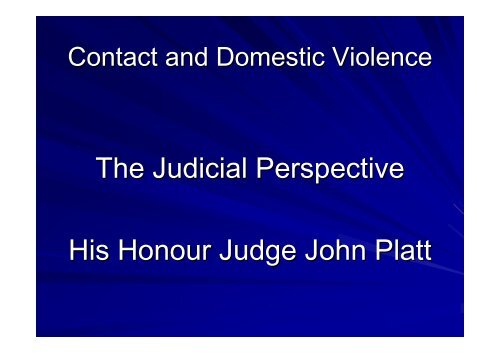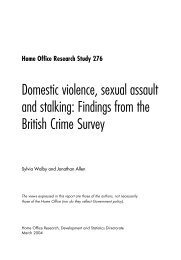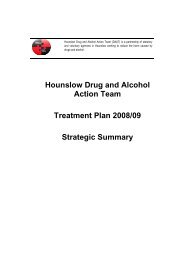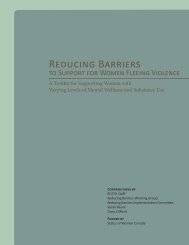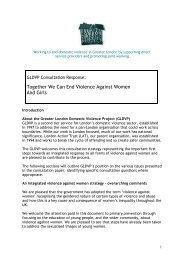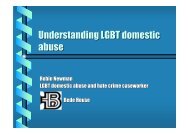The Judicial Perspective His Honour Judge John Platt
HH judge Platt - AVA
HH judge Platt - AVA
- No tags were found...
You also want an ePaper? Increase the reach of your titles
YUMPU automatically turns print PDFs into web optimized ePapers that Google loves.
Contact and Domestic Violence<br />
<strong>The</strong> <strong>Judicial</strong> <strong>Perspective</strong><br />
<strong>His</strong> <strong>Honour</strong> <strong>Judge</strong> <strong>John</strong> <strong>Platt</strong>
Whose right is it ?<br />
Contact is the right of the child NOT the<br />
parent<br />
NO mention of parents’<br />
rights in the<br />
Children Act; but<br />
Parents rights are included in the rights<br />
guaranteed by Article 8 of the EHRC<br />
Where there is a conflict children’s s welfare<br />
interests will prevail
<strong>The</strong> starting point<br />
Every child has a right to grow up with a<br />
loving relationship with both parents<br />
– It will only be curtailed or denied if there are<br />
cogent and compelling reasons to do so<br />
– It is the responsibility of parents to take the<br />
practical steps to ensure that this happens<br />
– Assisted if necessary by the Family Court and<br />
its support services
Cogent and compelling Reasons<br />
<strong>The</strong> decision of the Court of Appeal in Re L,V,M<br />
and H [2000] 2FLR 334 marked a sea change in<br />
the attitude of the courts towards Domestic<br />
Violence<br />
Recognition of indirect effects on children<br />
– Children may become victims simply by witnessing<br />
Domestic Violence<br />
– Women may be so seriously traumatised by Domestic<br />
Violence that their own parenting ability is or will be<br />
adversely affected if contact is ordered.<br />
Domestic Violence is not an automatic bar to<br />
contact but is recognised as a very important<br />
factor in the decision making process whether to<br />
order contact and if so what kind of contact
<strong>The</strong> 2008 Practice Direction<br />
Applies to<br />
– all cases where any question arises about<br />
residence or contact between a child and a<br />
parent or other family member – AND<br />
– Where it is alleged or there is reason to<br />
suppose<br />
that a child or a party has<br />
experienced Domestic Violence or there is a<br />
risk of Domestic Violence
What is Domestic Violence ?<br />
No precise definition but includes:<br />
– Physical violence<br />
– Threatening or intimidating behaviour<br />
– Any other form of abuse<br />
– which may have directly or indirectly caused harm to<br />
the other party or may give rise to the risk of harm.<br />
Harm in relation to a child means ill treatment or<br />
the impairment of health or development<br />
including impairment suffered from witnessing<br />
the ill treatment of another.
How does the court respond ?<br />
Once an issue of domestic violence arises<br />
the court must:<br />
– Identify the factual and welfare issues involved<br />
– Consider the nature of any allegation or<br />
admission and the extent to which this will be<br />
relevant to the issues or residence and<br />
contact before the court<br />
– Give directions to enable those factual and<br />
welfare issues to be determined fairly and<br />
expeditiously.
Taking a proactive role<br />
<strong>The</strong> court will decide whether a proposed<br />
consent order meets the welfare test in<br />
section 1(1) of the CA 1989<br />
Unless the parties are present in court, the<br />
court must be satisfied that there is no risk<br />
of harm to the child in making an order<br />
before it makes a consent order or allows<br />
an application to be withdrawn.
<strong>The</strong> first hearing<br />
<strong>The</strong> Court will have received the initial<br />
screening report from CAFCASS<br />
<strong>The</strong> parties will be told what is in the report<br />
unless the court considers that disclosure<br />
would create a risk of harm to a party or a<br />
child<br />
Court will decide whether allegations or<br />
admissions of Domestic Violence will be<br />
likely to affect the decision of the Court ?
Fact finding<br />
Once the court has identified that there are<br />
relevant contested issues of Domestic<br />
Violence it will usually direct a separate<br />
fact finding hearing with directions for<br />
– Statements from parties and witnesses<br />
– Information from police or medical records<br />
– Evidence from other sources
<strong>The</strong> fact finding hearing<br />
<strong>The</strong> court will record its findings in writing<br />
and serve a copy on the parties and<br />
CAFCASS<br />
Any admission of Domestic Violence<br />
whenever made will be put in writing and<br />
kept on the court file<br />
<strong>The</strong> judge who conducts the fact finding<br />
will also normally conduct any final hearing
Section 7 reports<br />
<strong>The</strong>se will normally be ordered in any case<br />
where Domestic Violence is raised as an issue<br />
Normally not expected to be filed until the<br />
completion of the fact finding hearing<br />
Following the fact finding hearing the court will<br />
re-consider the scope of any section 7 report<br />
ordered and CAFCASS may be invited to<br />
comment before a decision is made
Impact on the decision making<br />
process<br />
Findings of Domestic Violence are directly<br />
relevant to section 1(3) checklist<br />
– harm or risk of harm (section 1(3)(e)<br />
Orders for contact should only be made if<br />
the court is satisfied that the physical and<br />
emotional safety of the resident parent and<br />
the child can so far as possible be secured<br />
before during and after contact
Relevant factors<br />
<strong>The</strong> effect on the child and the resident parent of<br />
the Domestic Violence<br />
Is the application genuinely motivated or simply<br />
being used as a process of continued<br />
harassment<br />
Can the applicant be trusted to behave during<br />
contact ?<br />
Does the perpetrator appreciate the effect of past<br />
violence and the potential for future violence ?<br />
What is the attitude of the perpetrator towards<br />
past violence and does he have the capacity to<br />
change ?


